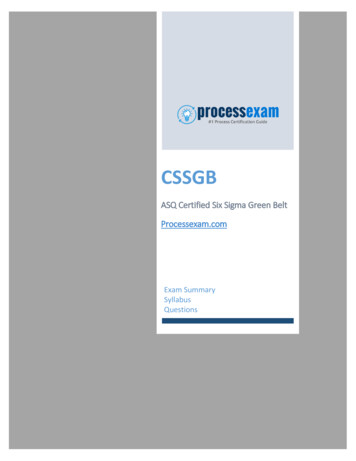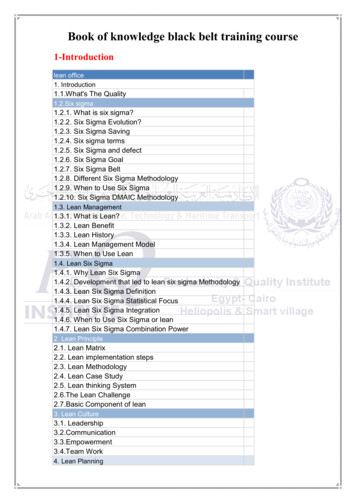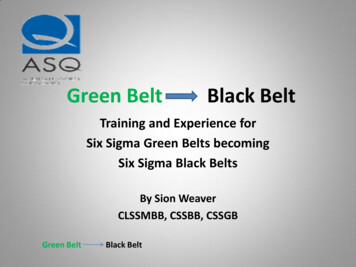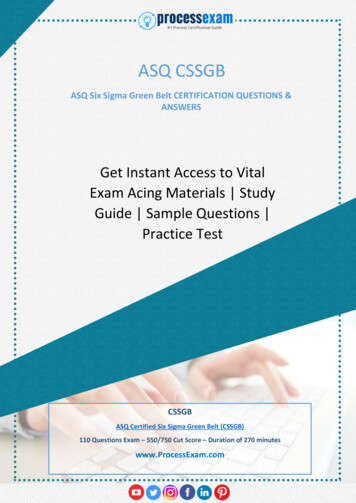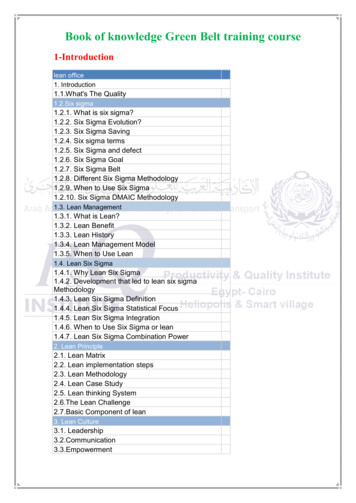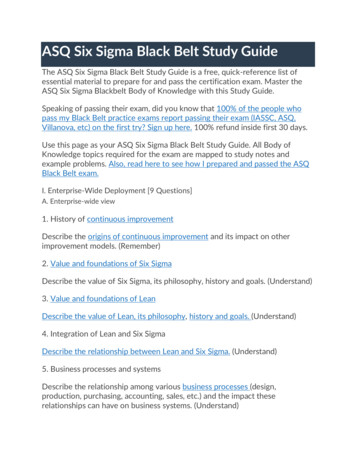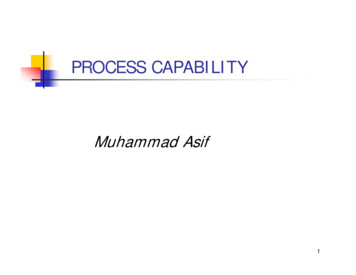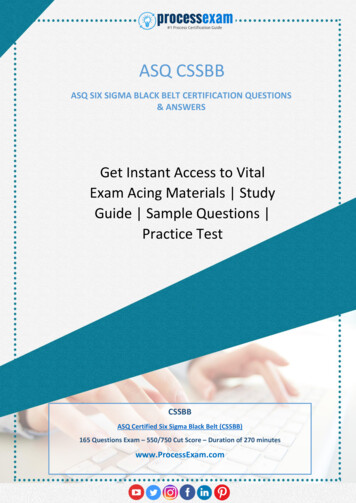
Transcription
ASQ CSSBBASQ SIX SIGMA BLACK BELT CERTIFICATION QUESTIONS& ANSWERSGet Instant Access to VitalExam Acing Materials StudyGuide Sample Questions Practice TestCSSBBASQ Certified Six Sigma Black Belt (CSSBB)165 Questions Exam – 550/750 Cut Score – Duration of 270 minuteswww.ProcessExam.com
CSSBB Exam QuestionsTable of ContentsDiscover More about the CSSBB Certification . 2ASQ CSSBB Six Sigma Black Belt Certification Details: 2CSSBB Syllabus: . 3I. Organization-Wide Planning and Deployment (Questions 12) . 3II. Organizational Process Management and Measures (10 Questions) 4III. Team Management (18 Questions). 4IV. Define (20 Questions) . 6V. Measure (25 Questions). 7VI. Analyze (22 Questions) . 9VII. Improve (21 Questions) . 11VIII. Control (15 Questions). 12IX. Design for Six Sigma (DFSS) Framework and Methodologies (7Questions) . 13Broaden Your Knowledge with ASQ CSSBB SampleQuestions: . 13Avail the Study Guide to Pass ASQ CSSBB Six SigmaBlack Belt Exam: . 16Career Benefits: . 17ASQ Six Sigma Black Belt Certification Practice Exam1
CSSBB Exam QuestionsDiscover More about the CSSBB CertificationAre you interested in passing the ASQ CSSBB exam? First discover, whobenefits from the CSSBB certification. The CSSBB is suitable for a candidate ifhe wants to learn about Business Process Improvement. Passing the CSSBBexam earns you the ASQ Certified Six Sigma Black Belt (CSSBB) title.While preparing for the CSSBB exam, many candidates struggle to get thenecessary materials. But do not worry; your struggling days are over. TheCSSBB PDF contains some of the most valuable preparation tips and thedetails and instant access to useful CSSBB study materials just at one click.ASQ CSSBB Six Sigma Black Belt CertificationDetails:Exam NameASQ Certified Six Sigma Black BeltExam CodeCSSBBExam FeeUSD ASQ MEMBERS - 438NON-MEMBERS - 538RETAKES - 338Exam Duration270 MinutesNumber ofQuestions165Passing Score550/750FormatMultiple Choice QuestionsCertified Six Sigma Black Belt Certification PreparationBooks / Trainings The ASQ Pocket Guide For The Certified Six Sigma BlackBeltSchedule ExamBook Your ExamSample QuestionsASQ Six Sigma Black Belt Exam Sample Questions andAnswersPractice ExamASQ Certified Six Sigma Black Belt (CSSBB) Practice TestASQ Six Sigma Black Belt Certification Practice Exam2
CSSBB Exam QuestionsCSSBB Syllabus:I. Organization-Wide Planning and Deployment (Questions 12)1. Fundamentals of Six Sigma and lean methodologies- Define and describe the value, foundations, philosophy,history, and goals of these approaches, and describe theintegration and complementary relationship between them.(Understand)A. OrganizationwideConsiderations2. Six Sigma, lean, and continuous improvementmethodologies- Describe when to use Six Sigma instead of other problemsolving approaches, and describe the importance of aligningSix Sigma objectives with organizational goals. Describescreening criteria and how such criteria can be used for theselection of Six Sigma projects, lean initiatives, and othercontinuous improvement methods. (Apply)3. Relationships among business systems and processes- Describe the interactive relationships among businesssystems, processes, and internal and external stakeholders,and the impact those relationships have on business systems.(Understand)4. Strategic planning and deployment for initiatives- Define the importance of strategic planning for Six Sigmaprojects and lean initiatives. Demonstrate how hoshin kanri(X-matrix), portfolio analysis, and other tools can be used insupport of strategic deployment of these projects. Usefeasibility studies, SWOT analysis (strengths, weaknesses,opportunities, and threats), PEST analysis (political,economic, social, and technological) and contingency planningand business continuity planning to enhance strategicplanning and deployment. (Apply)B. Leadership1. Roles and responsibilities- Describe the roles and responsibilities of executiveleadership, champions, sponsors, process owners, MasterBlack Belts, Black Belts, and Green Belts in driving Six Sigmaand lean initiatives. Describe how each group influencesproject deployment in terms of providing or managingresources, enabling changes in organizational structure, andsupporting communications about the purpose anddeployment of the initiatives. (Understand)2. Organizational roadblocks and change management- Describe how an organization’s structure and culture canimpact Six Sigma projects. Identify common causes of SixSigma failures, including lack of management support andlack of resources. Apply change management techniques,including stakeholder analysis, readiness assessments, andASQ Six Sigma Black Belt Certification Practice Exam3
CSSBB Exam Questionscommunication plans to overcome barriers and driveorganization-wide change. (Apply)II. Organizational Process Management and Measures (10Questions)A. Impact onStakeholders- Describe the impact Six Sigma projects can have oncustomers, suppliers, and other stakeholders. (Understand)B. Benchmarking- Define and distinguish between various types ofbenchmarking, e.g., best practices, competitive, collaborative,breakthrough. Select measures and performance goals forprojects resulting from benchmarking activities. (Apply)1. Performance measures- Define and describe balanced scorecard, key performanceindicators (KPIs), customer loyalty metrics, and leading andlagging indicators. Explain how to create a line of sight fromperformance measures to organizational strategies. (Analyze)C. BusinessMeasures2. Financial measures- Define and use revenue growth, market share, margin, netpresent value (NPV), return on investment (ROI), and costbenefit analysis (CBA). Explain the difference between hardcost measures (from profit and loss statements) and soft costbenefits of cost avoidance and reduction. (Apply)III. Team Management (18 Questions)1. Team types and constraints- Define and describe various teams, including virtual, crossfunctional, and self-directed. Determine what team type willwork best for a given a set of constraints, e.g., geography,technology availability, staff schedules, time zones. (Apply)A. Team Formation2. Team roles and responsibilities- Define and describe various team roles and responsibilitiesfor leader, facilitator, coach, and individual member.(Understand)3. Team member selection criteria- Describe various factors that influence the selection of teammembers, including the ability to influence, openness tochange, required skill sets, subject matter expertise, andavailability. (Apply)4. Team success factors- Identify and describe the elements necessary for successfulteams, e.g., management support, clear goals, ground rules,timelines. (Apply)B. Team Facilitation 1. Motivational techniques- Describe and apply techniques to motivate team members.ASQ Six Sigma Black Belt Certification Practice Exam4
CSSBB Exam QuestionsIdentify factors that can demotivate team members anddescribe techniques to overcome them. (Apply)2. Team stages of development- Identify and describe the classic stages of teamdevelopment: forming, storming, norming, performing, andadjourning. (Apply)3. Team communication- Describe and explain the elements of an effectivecommunication plan, e.g., audience identification, messagetype, medium, frequency. (Apply)4. Team leadership models- Describe and select appropriate leadership approaches (e.g.,direct, coach, support, delegate) to ensure team success.(Apply)1. Group behaviors- Identify and use various conflict resolution techniques (e.g.,coaching, mentoring, intervention) to overcome negativegroup dynamics, including dominant and reluctantparticipants, groupthink, rushing to finish, and digressions.(Evaluate)2. Meeting managementC. Team Dynamics - Select and use various meeting management techniques,including using agendas, starting on time, requiring pre-workby attendees, and ensuring that the right people andresources are available. (Apply)3. Team decision-making methods- Define, select, and use various tools (e.g., consensus,nominal group technique, multi-voting) for decision making.(Apply)1. Needs assessment- Identify the steps involved to implement an effectivetraining curriculum: identify skills gaps, develop learningobjectives, prepare a training plan, and develop trainingmaterials. (Understand)D. Team Training2. Delivery- Describe various techniques used to deliver effectivetraining, including adult learning theory, soft skills, andmodes of learning. (Understand)3. Evaluation- Describe various techniques to evaluate training, includingevaluation planning, feedback surveys, pre-training and posttraining testing. (Understand)ASQ Six Sigma Black Belt Certification Practice Exam5
CSSBB Exam QuestionsIV. Define (20 Questions)1. Customer Identification- Identify and segment customers and show how a project willimpact both internal and external customers. (Apply)A. Voice of theCustomer2. Customer data collection- Identify and select appropriate data collection methods(e.g., surveys, focus groups, interviews, observations) togather voice of the customer data. Ensure the data collectionmethods used are reviewed for validity and reliability.(Analyze)3. Customer requirements- Define, select, and apply appropriate tools to determinecustomer needs and requirements, including critical-to-X (CTXwhen “X” can be quality, cost, safety, etc.), CTQ tree, qualityfunction deployment (QFD), supplier, input, process, output,customer (SIPOC), and Kano model. (Analyze)1. Business case- Describe business case justification used to supportprojects. (Understand)2. Problem statement- Develop a project problem statement and evaluate it inrelation to baseline performance and improvement goals.(Evaluate)3. Project scope- Develop and review project boundaries to ensure that theproject has value to the customer. (Analyze)B. Business Case4. Goals and objectivesand Project Charter- Identify specific, measureable, actionable, relevant, andtime bound (SMART) goals and objectives on the basis of theproject’s problem statement and scope. (Analyze)5. Project performance measurements- Identify and evaluate performance measurements (e.g.,cost, revenue, delivery, schedule, customer satisfaction) thatconnect critical elements of the process to key outputs.(Analyze)6. Project charter review- Explain the importance of having periodic project charterreviews with stakeholders. (Understand)Identify and use the following PM tools to track projects andC. Projectdocument their progress. (Evaluate)Management (PM) 1. Gantt chartsTools2. Toll-gate reviews3. Work breakdown structure (WBS)ASQ Six Sigma Black Belt Certification Practice Exam6
CSSBB Exam Questions4. RACI model (responsible, accountable, consulted, andinformed)Identify and use the following analytical tools throughout theDMAIC cycle. (Apply)1. Affinity diagramsD. Analytical Tools 2. Tree diagrams3. Matrix diagrams4. Prioritization matrices5. Activity network diagramsV. Measure (25 Questions)A. ProcessCharacteristics1. Process flow metrics- Identify and use process flow metrics (e.g., work in progress(WIP), work in queue (WIQ), touch time, takt time, cycletime, throughput) to determine constraints. Describe theimpact that “hidden factories” can have on process flowmetrics. (Analyze)2. Process analysis tools- Select, use, and evaluate various tools, e.g., value streammaps, process maps, work instructions, flowcharts, spaghettidiagrams, circle diagrams, gemba walk. (Evaluate)1. Types of data- Define, classify, and distinguish between qualitative andquantitative data, and continuous and discrete data.(Evaluate)2. Measurement scales- Define and use nominal, ordinal, interval, and ratiomeasurement scales. (Apply)B. Data Collection3. Sampling- Define and describe sampling concepts, includingrepresentative selection, homogeneity, bias, accuracy, andprecision. Determine the appropriate sampling method (e.g.,random, stratified, systematic, subgroup, block) to obtainvalid representation in various situations. (Evaluate)4. Data collection plans and methods- Develop and implement data collection plans that includedata capture and processing tools, e.g., check sheets, datacoding, data cleaning (imputation techniques). Avoid datacollection pitfalls by defining the metrics to be used orcollected, ensuring that collectors are trained in the tools andunderstand how the data will be used, and checking forseasonality effects. (Analyze)C. MeasurementSystems1. Measurement system analysis (MSA)- Use gauge repeatability and reproducibility (R&R) studiesand other MSA tools (e.g., bias, correlation, linearity,ASQ Six Sigma Black Belt Certification Practice Exam7
CSSBB Exam Questionsprecision to tolerance, percent agreement) to analyzemeasurement system capability. (Evaluate)2. Measurement systems across the organization- Identify how measurement systems can be applied tomarketing, sales, engineering, research and development(R&D), supply chain management, and customer satisfactiondata. (Understand)3. Metrology- Define and describe elements of metrology, includingcalibration systems, traceability to reference standards, andthe control and integrity of measurement devices andstandards. (Understand)1. Basic statistical terms- Define and distinguish between population parameters andsample statistics, e.g., proportion, mean, standard deviation.(Apply)2. Central limit theorem- Explain the central limit theorem and its significance in theapplication of inferential statistics for confidence intervals,hypothesis tests, and control charts. (Understand)D. Basic Statistics3. Descriptive statistics- Calculate and interpret measures of dispersion and centraltendency. (Evaluate)4. Graphical methods- Construct and interpret diagrams and charts, e.g., box-andwhisker plots, scatter diagrams, histograms, normalprobability plots, frequency distributions, cumulativefrequency distributions. (Evaluate)5. Valid statistical conclusions- Distinguish between descriptive and inferential statisticalstudies. Evaluate how the results of statistical studies areused to draw valid conclusions. (Evaluate)E. Probability1. Basic concepts- Describe and apply probability concepts, e.g., independence,mutually exclusive events, addition and multiplication rules,conditional probability, complementary probability, jointoccurrence of events. (Apply)2. Distributions- Describe, interpret, and use various distributions, e.g.,normal, Poisson, binomial, chi square, Student’s t, F,hypergeometric, bivariate, exponential, lognormal, Weibull.(Evaluate)F. ProcessCapability1. Process capability indices- Define, select, and calculate Cp and Cpk. (Evaluate)ASQ Six Sigma Black Belt Certification Practice Exam8
CSSBB Exam Questions2. Process performance indices- Define, select, and calculate Pp, Ppk, Cpm, and processsigma. (Evaluate)3. General process capability studies- Describe and apply elements of designing and conductingprocess capability studies relative to characteristics,specifications, sampling plans, stability, and normality.(Evaluate)4. Process capability for attributes data- Calculate the process capability and process sigma level forattributes data. (Apply)5. Process capability for non-normal data- Identify non-normal data and determine when it isappropriate to use Box-Cox or other transformationtechniques. (Apply)6. Process performance vs. specification- Distinguish between natural process limits and specificationlimits. Calculate process performance metrics, e.g., percentdefective, parts per million (PPM), defects per millionopportunities (DPMO), defects per unit (DPU), throughputyield, rolled throughput yield (RTY). (Evaluate)7. Short-term and long-term capability- Describe and use appropriate assumptions and conventionswhen only short-term data or only long-term data areavailable. Interpret the relationship between short-term andlong-term capability. (Evaluate)VI. Analyze (22 Questions)1. Correlation coefficient- Calculate and interpret the correlation coefficient and itsconfidence interval, and describe the difference betweencorrelation and causation. (Evaluate)A. Measuring andModelingRelationshipsBetween Variables2. Linear regression- Calculate and interpret regression analysis, and apply andinterpret hypothesis tests for regression statistics. Use theregression model for estimation and prediction, analyze theuncertainty in the estimate, and perform a residuals analysisto validate the model. (Evaluate)3. Multivariate tools- Use and interpret multivariate tools (e.g., factor analysis,discriminant analysis, multiple analysis of variance(MANOVA)) to investigate sources of variation. (Evaluate)B. HypothesisTesting1. Terminology- Define and interpret the significance level, power, type I,and type II errors of statistical tests. (Evaluate)ASQ Six Sigma Black Belt Certification Practice Exam9
CSSBB Exam Questions2. Statistical vs. practical significance- Define, compare, and interpret statistical and practicalsignificance. (Evaluate)3. Sample size- Calculate sample size for common hypothesis tests: equalityof means and equality of proportions. (Apply)4. Point and interval estimates- Define and distinguish between confidence and predictionintervals. Define and interpret the efficiency and bias ofestimators. Calculate tolerance and confidence intervals.(Evaluate)5. Tests for means, variances, and proportions- Use and interpret the results of hypothesis tests for means,variances, and proportions. (Evaluate)6. Analysis of variance (ANOVA)- Select, calculate, and interpret the results of ANOVAs.(Evaluate)7. Goodness-of-fit (chi square) tests- Define, select, and interpret the results of these tests.(Evaluate)8. Contingency tables- Select, develop, and use contingency tables to determinestatistical significance. (Evaluate)9. Nonparametric tests- Understand the importance of the Kruskal-Wallis and MannWhitney tests and when they should be used. (Understand)- Describe the purpose and elements of FMEA, including riskC. Failure Mode and priority number (RPN), and evaluate FMEA results forEffects Analysisprocesses, products, and services. Distinguish between design(FMEA)FMEA (DFMEA) and process FMEA (PFMEA), and interpret theirresults. (Evaluate)1. Gap analysis- Analyze scenarios to identify performance gaps, andcompare current and future states using predefined metrics.(Analyze)D. AdditionalAnalysis Methods2. Root cause analysis- Define and describe the purpose of root cause analysis,recognize the issues involved in identifying a root cause, anduse various tools (e.g., 5 whys, Pareto charts, fault treeanalysis, cause and effect diagrams) to resolve chronicproblems. (Analyze)3. Waste analysis- Identify and interpret the seven classic wastes(overproduction, inventory, defects, over-processing, waiting,ASQ Six Sigma Black Belt Certification Practice Exam10
CSSBB Exam Questionsmotion, transportation) and resource under-utilization.(Analyze)VII. Improve (21 Questions)1. Terminology- Define basic DOE terms, e.g., independent and dependentvariables, factors and levels, response, treatment, error,nested. (Understand)2. Design principles- Define and apply DOE principles, e.g., power, sample size,balance, repetition, replication, order, efficiency,randomization, blocking, interaction, confounding, resolution.(Apply)3. Planning experiments- Plan and evaluate DOEs by determining the objective,A. Design ofselecting appropriate factors, responses, and measurementExperiments (DOE) methods, and choosing the appropriate design. (Evaluate)4. One-factor experiments- Design and conduct completely randomized, randomizedblock, and Latin square designs, and evaluate their results.(Evaluate)5. Two-level fractional factorial experiments- Design, analyze, and interpret these types of experiments,and describe how confounding can affect their use. (Evaluate)6. Full factorial experiments- Design, conduct, and analyze these types of experiments.(Evaluate)1. Waste elimination- Select and apply tools and techniques for eliminating orpreventing waste, e.g., pull systems, kanban, 5S, standardwork, poka-yoke. (Analyze)B. Lean Methods2. Cycle-time reduction- Use various tools and techniques for reducing cycle time,e.g., continuous flow, single-minute exchange of die (SMED),heijunka (production leveling). (Analyze)3. Kaizen- Define and distinguish between kaizen and kaizen blitz anddescribe when to use each method. (Apply)4. Other improvement tools and techniques- Identify and describe how other process improvementmethodologies are used, e.g., theory of constraints (TOC),overall equipment effectiveness (OEE). (Understand)ASQ Six Sigma Black Belt Certification Practice Exam11
CSSBB Exam Questions- Develop plans for implementing proposed improvements,C. Implementation including conducting pilot tests or simulations, and evaluateresults to select the optimum solution. (Evaluate)VIII. Control (15 Questions)1. Objectives- Explain the objectives of SPC, including monitoring andcontrolling process performance, tracking trends, runs, andreducing variation within a process. (Understand)2. Selection of variables- Identify and select critical process characteristics for controlchart monitoring. (Apply)A. StatisticalProcess Control(SPC)3. Rational subgrouping- Define and apply the principle of rational subgrouping.(Apply)4. Control chart selection- Select and use control charts in various situations: X-R, X-s,individual and moving range (ImR), p, np, c, u, short-runSPC, and moving average. (Apply)5. Control chart analysis- Interpret control charts and distinguish between commonand special causes using rules for determining statisticalcontrol. (Analyze)1. Total productive maintenance (TPM)- Define the elements of TPM and describe how it can be usedto consistently control the improved process. (Understand)B. Other ControlsC. MaintainControlsD. SustainImprovements2. Visual controls- Define the elements of visual controls (e.g., pictures ofcorrect procedures, color-coded components, indicator lights),and describe how they can help control the improved process.(Understand)1. Measurement system reanalysis- Review and evaluate measurement system capability asprocess capability improves, and ensure that measurementcapability is sufficient for its intended use. (Evaluate)2. Control plan- Develop a control plan to maintain the improved processperformance, enable continuous improvement, and transferresponsibility from the project team to the process owner.(Apply)1. Lessons learned- Document the lessons learned from all phases of a projectASQ Six Sigma Black Belt Certification Practice Exam12
CSSBB Exam Questionsand identify how improvements can be replicated and appliedto other processes in the organization. (Apply)2. Documentation- Develop or modify documents including standard operatingprocedures (SOPs), work instructions, and control plans toensure that the improvements are sustained over time.(Apply)3. Training for process owners and staff- Develop and implement training plans to ensure consistentexecution of revised process methods and standards tomaintain process improvements. (Apply)4. Ongoing evaluation- Identify and apply tools (e.g., control charts, control plans)for ongoing evaluation of the improved process, includingmonitoring leading indicators, lagging indicators, andadditional opportunities for improvement. (Apply)IX. Design for Six Sigma (DFSS) Framework and Methodologies (7Questions)A. Common DFSSMethodologies- Identify and describe define, measure, analyze, design, andvalidate (DMADV) and define, measure, analyze, design,optimize, and validate (DMADOV). (Understand)B. Design for X(DFX)- Describe design constraints, including design for cost,design for manufacturability (producibility), design for test,and design for maintainability. (Understand)C. Robust Designs- Describe the elements of robust product design, tolerancedesign, and statistical tolerancing. (Understand)Broaden Your Knowledge with ASQ CSSBBSample Questions:Question: 1Which of the following is most important in evaluating and understanding design intent?Please choose the correct answer.a)b)c)d)Identifying the functional requirementBrainstorming failure modesConducting computer simulationsDeveloping FMEAAnswer: aASQ Six Sigma Black Belt Certification Practice Exam13
CSSBB Exam QuestionsQuestion: 2Which of the following will have the most influence on consumers’ perception of quality?Please choose the correct answer.a)b)c)d)Industry standardsCompany financial performanceAudit resultsService and repair policiesAnswer: dQuestion: 3Typically, which of the following actions is NOT used to reduce process cycle time?Please choose the correct answer.a)b)c)d)Analyzing current processesReducing queue timesSetting scheduling prioritiesImplementing activity-based costingAnswer: dQuestion: 4If a process follows an exponential distribution with a mean of 25, what is the standarddeviation for the process?Please choose the correct answer.a)b)c)d)0.45.012.525.0Answer: dQuestion: 5Correction, over-production, inventory, and motion are all examples ofPlease choose the correct answer.a)b)c)d)waste5S target areasNoisevalue-added activitiesAnswer: aASQ Six Sigma Black Belt Certification Practice Exam14
CSSBB Exam QuestionsQuestion: 6One characteristic of attributes data is that it is alwaysPlease choose the correct answer.a)b)c)d)continuousdiscreteexpensive to collectread from a scale of measurementAnswer: bQuestion: 7A change agent is responsible for helping the organization do which of the following?Please choose the correct answer.a)b)c)d)Overcome fear of the unknownReorganize departmentsDetermine performance criteriaIdentify which group is responsible for failuresAnswer: aQuestion: 8Which of the following terms is used to describe the risk of a type I error in a hypothesistest?Please choose the correct answer.a)b)c)d)PowerConfidence levelLevel of significanceBeta riskAnswer: cQuestion: 9The process of having a six sigma team develop a problem statement helps the team to?Please choose the correct answer.a)b)c)d)agree on key dates associated with completing major project phasesachieve consensus and ownership of the processdetermine solutionsdetermine how often it should meetAnswer: bASQ Six Sigma Black Belt Certification Practice Exam15
CSSBB Exam QuestionsQuestion: 10Which of the following best describes a controlled variable whose influence on a response isbeing studied?Please choose the correct answer.a)b)c)d)ReplicateVersionLevelFactorAnswer: dAvail the Study Guide to Pass ASQ CSSBB SixSigma Black Belt Exam: Find out about the CSSBB syllabus topics. Visiting the official site offersan idea about the exam structure and other important study resources.Going through the syllabus topics help to plan the exam in an organizedmanner. Once you are done exploring the CSSBB syllabus, it is time to plan forstudying and covering the syllabus topics from the core. Chalk out thebest plan for yourself to cover each part of the syllabus in a hassle-freemanner. A study schedule helps you to stay calm throughout your exampreparation. It should contain your materials and thoughts like studyhours, number of topics for daily studying mentioned on it. The best betto clear the exam is to follow your schedule rigorously. The candidate should not miss out on the scope to learn from the CSSBBtraining. Joining the ASQ provided training for CSSBB exam helps acandidate to strengthen his practical knowledge base from thecertification. Learning about the probable questions and gaining knowledge regardingthe exam structure helps a lot. Go through the CSSBB samplequestions and boost your knowledge Make yourself a pro through online practicing the syllabus topics. CSSBBpractice tests would guide you on your strengths and weaknessesregarding the syllabus topics. Through rigorous practicing, you canimprove the weaker sections too. Learn well about time managementduring exam and become confident gradually with practice tests.ASQ Six Sigma Black Belt Certification Practice Exam16
CSSBB Exam QuestionsCareer Benefits:Passing the CSSBB exam, helps a candidate to prosper highly in his career. Havingthe certification on the resume adds to the candidate's benefit and helps to getthe best opportunities.Here Is the Trusted Practice Test for the CSSBB CertificationProcessExam.Com is here with all the necessary details regarding the CSSBBexam. We provide authentic practice tests for the CSSBB exam. What do you gainfrom these practice tests? You get to experience the real exam-like questionsmade by industry experts and get a scope to improve your performance in theactual exam. Rely on ProcessExam.Com for rigorous, unlimited two-monthattempts on the CSSBB practice tests, and gradually build your confidence.Rigorous practice made many aspirants successful and made their journey easytowards grabbing the ASQ Certified Six Sigma Black Belt (CSSBB).Start Online Practice of CSSBB Exam by Visiting ix-sigma-black-beltcssbbASQ Six Sigma Bla
DMAIC cycle. (Apply) 1. Affinity diagrams 2. Tree diagrams 3. Matrix diagrams 4. Prioritization matrices 5. Activity network diagrams V. Measure (25 Questions) A. Process Characteristics 1. Process flow metrics - Identify and use process flow metrics (e.g., work in progress (WIP), work in queue (WIQ), touch time, takt time, cycle

